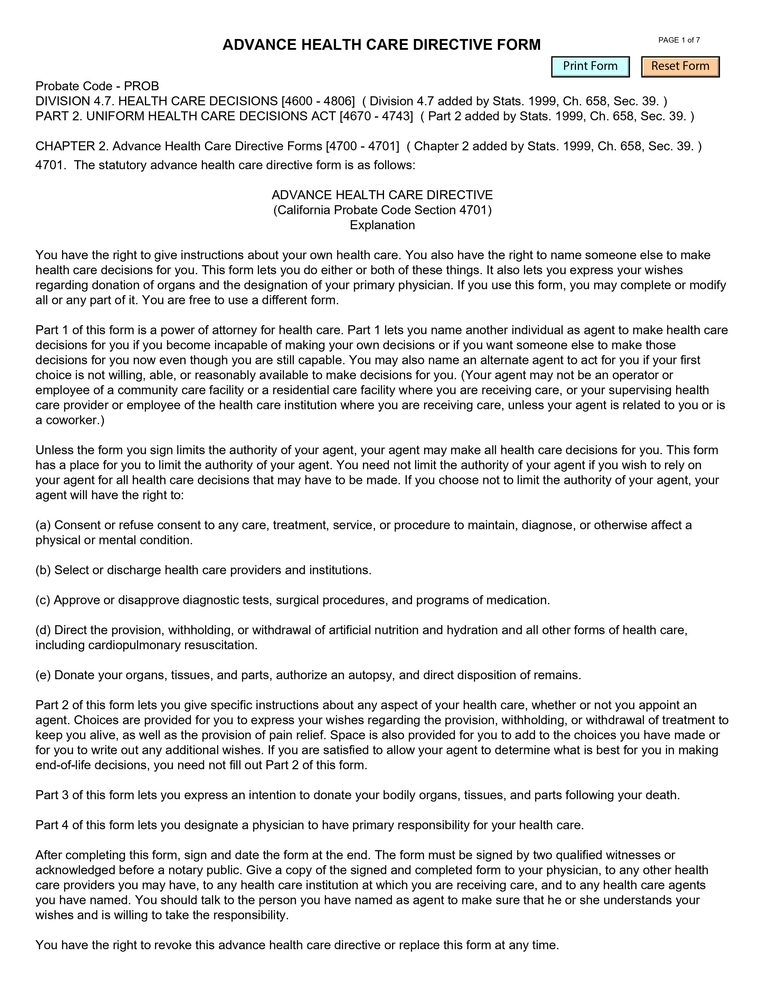Official California Health Care Directive form is a quite complex document consisting of medical power of attorney section, health care instructions, and organ donation instructions upon death. Some of the parts are not obligatory and may be left out. The first page contains a lot of information on what the form allows you to do and your rights. Below is a detailed explanation of how to fill out the form with no errors.
Part 1. Fill Out the Power of Attorney for Health Care Section
In this part, you determine the person who will represent your will and be able to make any health-related decisions on your behalf if needed. You can also limit the agent's decisions if you want to.
Step 1. Introduce your designated agent
The first step is to identify the agent that will make health care decisions on your behalf. Specify the following:
-
Full name
-
Address (street, city, state, zip)
-
Home and work phone numbers
Step 2. Optionally, provide the name of alternative agent(s)
You can also add alternative agents if the original one cannot fulfill their duties. To do so, please provide the following details:
-
Full name
-
Address (street, city, state, zip)
-
Home and work phone numbers
Step 3. Limit the authority of your agent if needed
You can determine the scope of medical decisions your designated agent(s) can make. You can leave this section blank if you fully trust the assigned person. You can also attach an additional sheet if there is insufficient space for your commentary regarding these restrictions.
Step 4. Specify the effectiveness of the POA
You can check the box at the bottom of the second page to make this directive effective immediately. Otherwise, it will be effective the moment your doctor determines your incapacity to make health decisions yourself.
Step 5. Clarify the agent's post-death authority
Determine the actions of the designated agent(s) in case of your death. If you want to limit the agent's authority to donate your organs or other actions, you can list all of them in the blanks under section (1.5).
Part 2. Instructions for Health Care
In this part, you may declare your decisions that must not be changed even when you lose your ability to make them.
Step 1. End-of-Life decisions
Here, you can indicate whether you want to prolong your life if you have incurable conditions or have a low chance of regaining consciousness by checking the box that corresponds to your choice.
Step 2. Relief from pain
You can choose if you want to continue to receive pain-relievers even if they may worsen your condition and provide exceptions to this statement in this part.
Step 3. Other wishes
If you want to give the instructions not mentioned in the text, you can use the provided space to list all your requirements.
Part 3. Donations of organs, tissues, or parts at death (optional)
This section is optional for those and is designed for those who want to clarify their will upon death. You can determine which organs you want to donate for research, education, or transplant purposes. If you don’t want to provide any donations, just don't do anything here.
Step 1. Clarify the will to donate
You need to check box 3.1 to demonstrate your willingness to donate your organs, tissues, or parts at death. You can skip this step.
Step 2. Strike through the purposes you don't want
Strike through the purposes you don't want to donate your organs for. All will apply if you leave them as is.
Step 3. Restrict actions
If you want to give a restricted number of organs for donation, you can declare your wish in the provided text area.
Part 4. Primary Physician (optional)
You can determine the primary physician if you want to. The primary physician is a doctor responsible for the course of your medical treatment. You’re encouraged to ask the physician to add their name and contacts in your directive to ensure they will not decline your request.
Step 1. Clarify the name and contact details
Provide the contact details of the primary physician, including their:
Step 2. Provide an alternative option
If the first physician cannot be reached or is not able or doesn't desire to be your primary physician, you can indicate the alternate physician.
To do so, list down their information, such as:
Part 5. Authorization
This is the obligatory section where you must sign the document.
Step 1. Provide the document date
Type in the date when the document is signed in the corresponding field.
Step 2. Identify the contact details
After that, you need to enter your (if you are the patient) printed name and address.
Step 3. Sign the document
To show that you agree and authorize this directive, you must sign the document.
Step 4. Statement of witnesses
For this form to be considered valid, it must be signed in the presence of two witnesses. They must provide their full names, contact details, and signatures in this part.
Step 5. Additional statement of witnesses
This statement must be signed by at least one of the witnesses. They declare that the witnesses are not relatives of the person who executes this directive by signing it.
Part 6. Special Witness Requirement
This part is required when the patient is in the skilled nursing facility. In this case, the patient ombudsman or advocate must sign the document as a particular witness. This part must contain the following information in regards to the patient ombudsman:
-
The date of the signature
-
Address (street, city, state, zip code)
-
Full name
-
Signature
Part 7. Notary Acknowledgement (optional)
If you don't have two witnesses to sign the document, you can alternatively notarize it. The notary public should fill all the fields on this last page.
